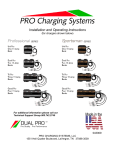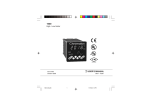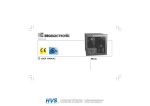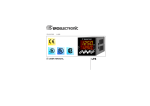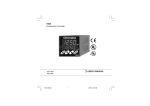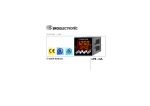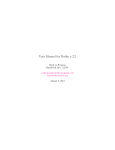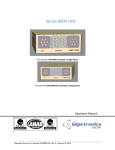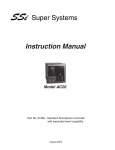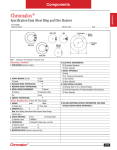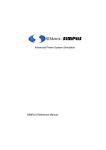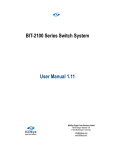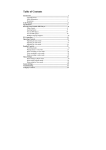Download 1605 Cover - Chromalox
Transcript
1605 1/16 DIN Temperature Controller Issue Date January 1998 ❒ USER’S MANUAL 0037-75342 Contents Model Identification .................................................................................................................................... Page ii Dimensions and Panel Cutout ............................................................................................................................1 Wiring ...........................................................................................................................................................................2 Hardware Setup .......................................................................................................................................................8 Configuration Procedure .................................................................................................................................... 10 Operator Mode ...................................................................................................................................................... 20 Display Functions .......................................................................................................................................... 20 Pushbutton Functions in Operator Mode ............................................................................................ 21 Operating Modes .......................................................................................................................................... 23 Instrument Status Indication .................................................................................................................... 26 Direct Access to Setpoint .......................................................................................................................... 27 SMART Function ........................................................................................................................................... 27 Operator Parameters ................................................................................................................................... 28 Error Messages ..................................................................................................................................................... 31 Warranty and Return ........................................................................................................................................... 33 Chromalox 1605 User's Manual i Model Identification Model 1605 SMART Self-Tuning, Programmable 5-Segment Ramp/Soak Profile, 3 Outputs, Dual 4-Digit Display of Process and Setpoint, Field Selectable Universal Thermocouple, RTD, Voltage or Current Inputs, AutoManual Control, Programmable Alarms, 0.1 Degree Display Resolution, IEC 801-4 Noise Immunity, IP65 and NEMA 4X Splashproof Faceplate. Code 1 6 Output 1 - Heat or Cool Relay, 3 Amps at 240 Vac SSR Drive, 14V @ 20mA, Jumper Selectable Code Output 2 - Alarm or Event 1 Relay, 2 Amps at 240 Vac Code Output #3 - Alarm or End-of-Cycle Indicator 1 Relay, 2 Amps at 250 Vac Code 3 5 1605 ii 1 1 1 3 Power Supply 100-240 Vac 24 Vac/dc Code 0 Add to complete model number 0 Typical Model Number Chromalox 1605 User's Manual Mounting Select a mounting location within the following guidelines: • Minimal vibration. • An ambient temperature range between 32°F and 122°F (0°C and 50°C). • Easy access to the rear of the controller. • No corrosive gases (sulfuric gas, ammonia, etc.). • No water or other fluid (i.e. condensation). • Relative humidity of 20% to 80% non-condensing. The controller can be mounted on a panel up to 0.591" (15 mm) thick with a square cutout of 1.772" x 1.772" (45 mm x 45 mm). Panel surface texture must be better than 6.3 μmm. Install the controller as follows: 1. Insert the 1605 controller in the gasket. 2. Insert the controller in the panel cutout. 3. Pushing the controller against the panel, slide the mounting bracket on to the rear of the controller. 4. Tighten the mounting bracket screws. 5. To insure NEMA 4X/IP65 protection, make sure the controller fits snugly within the cutout. Dimensions and Panel Cutout Figure 1 Controller Dimensions The controller is shipped with a rubber panel gasket. To assure the IP65 and NEMA 4 protection, insert the panel gasket between the controller and the panel. 3.0 (75) 2.4 (60) 1.77 (45) 4.13 (105) 1.9 (48) OUTPUT 1.77 (45) 1 2 3 MAN REM ˚C ˚F SMRT SP2 NC AN FU M 1600 1.9 (48) Chromalox 1605 User’s Manual 1 Wiring Wiring Guidelines Sensor Inputs Note: Any external components (like Zener diodes, etc.) connected between sensor and input terminals may cause errors in measurement due to excessive and/or not balanced line resistance or possible leakage currents. NO C 2 13 NO 3 14 15 4 5 TC Input OUT 2/3 Figure 3 Thermocouple Input Wiring OUT 3 + 10 PWR LINE 10 12 OUT 2 100 / 240 Vac T/C 9 + LINEAR - 8 1 11 Logic Input - SSR + C 7 RTD OUT 1 6 NO Figure 2 Rear Terminal Connections - 9 + 10 - 9 2 Chromalox 1605 User’s Manual Notes: 1. Do not run input wires with power cables. 2. For TC wiring use proper compensating cable (use type J TC extension wire with type J TC connections), preferably shielded. 3. Shielded cable should be grounded at one end only. RTD Input Wiring Notes: 1. Do not run input wires together with power cables. 2. Observe the line resistance; a high line resistance may cause measurement errors. 3. When shielded cable is used, it should be grounded at one side only to avoid ground loop currents. 4. The resistance of the 3 wires must be the same. RTD Input Linear Input TC Inputs (continued) Figure 5 mA, mV and V Inputs Wiring Figure 4 RTD RTD 10 + mA mV or 9 - 10 + V mA mV 9 8 9 10 8 9 - 10 or V G Chromalox 1605 User’s Manual 3 Linear Input (continued) Notes: 1. Do not run input wires together with power cables. 2 Pay attention to the line resistance; a high line resistance may cause measurement errors. 3. When shielded cable is used, it should be grounded at one side only to avoid ground loop currents. 4. The input impedance is equal to: • Less than 5Ω for 20 mAdc input • Greater than 1 MΩ for 60 mVdc input • Greater than 400 KΩ for 5 Vdc and 10 Vdc input Logic Inputs Figure 6 Logic Inputs 14 15 Relay Outputs Figure 7 Relay Outputs 1 OUT 1 The logic input is used to Start/Stop the ramp/soak program using an external contact. Safety Notes: • Do not run logic input wiring with AC power cables. • Use an external contact with a contact rating greater than 0.5 mA, 5 Vdc. • The controller needs 100 ms to recognize a contact status variation. • The logic inputs are NOT isolated from the measuring input. 4 NO - OUT 2 2 C - OUT 2/3 NC - OUT 3 OUT 2 (AL1) 3 C 6 OUT 3 (AL2) NO 7 Chromalox 1605 User’s Manual Relay Outputs (continued) All relay contacts are protected by varistor against inductive loads with inductive components up to 0.5 A. The OUT 1 contact rating is 3A/250Vac resistive load. The OUT 2 and OUT 3 contact rating is 2A/250Vac resistive load. The number of operations is 1 x 105 at specified rating. Notes: 1. To avoid electric shock, connect power line at the end of the wiring procedure. 2. For power connections use No 16 AWG or larger wires rated for at last 75 °C. 3. Use copper conductors only. 4. Do not run input wires together with power cables. Inductive Loads Employing the following recommendations will help avoid serious problems that may occur when relay outputs are used with inductive loads. High voltage transients may occur when switching inductive loads. Through the internal contacts these transients may introduce disturbances that can affect the performance of the controller. For all the outputs, the internal protection (varistor) assures a correct protection up to 0.5 A of inductive component. The same problem may occur when a switch is used in series with the internal contacts as shown in Figure 8. Figure 8 External Switch in Series with the Internal Contact C R Power Line Load Chromalox 1605 User’s Manual 5 Inductive Loads (continued) Warnings: 1. When a relay output is used to drive an inductive load, it is suggested that you connect an external snubber network (RC) across the terminals using Chromalox P/N 0149-01305. 2. Do not run input wires together with power cables. 3. For TC wiring, use matching thermocouple extension wire (i.e. Type J extension wire for Type J thermocouple. 4. When using a shielded cable for input wires, the shield should be grounded at one point only. Voltage Outputs for SSR Drive The SSR Drive Output is a time proportioning output. Logic Level 0: Vout < 0-5 Vdc Logic Level 1: 14V ± 20% @ 17mA +24V ± 20% @ 1mA Maximum = 17mA Notes: 1. This output is not isolated. An external solid state relay must be used to isolate the controller output and power supply. 2. To determine Output #1 output type, check the tag on your controller and compare it to the model identification table on page ii. Figure 9 SSR Drive Output Wiring + 6 + OUT 1 7 6 - ˜ Chromalox 1605 User’s Manual Power Line and Grounding Figure 10 Power Supply N 4 Type Current Voltage 24 V AC/DC T 500 mA 250 V 100/240 V AC T 125 mA 250 V When the fuse is damaged, it is advisable to verify the power supply circuit. Return the controller to Chromalox for test and verification. Power Supply 100 to 240 Vac or 24 Vac/Vdc 5 R (S, T) Power supply R (S, T) N Notes: 1. Before connecting the power line, check that the voltage is correct (see Model Identification, pg. ii). 2. For supply connections use 16 AWG or larger wires rated for at least 75 °C. 3. Use copper conductors only. 4. Do not run input wires with power cables. 5. Polarity does not matter for 24 Vdc wiring. 6. The power supply input is NOT fuse protected. Please provide external fusing. Chromalox 1605 User’s Manual 7. Safety requirements for permanently connected equipment: • Include a switch or circuit-breaker in the installation. • Place the switch in close proximity to the equipment and within easy reach of the operator. • Mark the switch as the disconnecting device for the equipment. Note: A single switch or circuit-breaker can drive more than one controller. 8. When the NEUTRAL line is present, connect it to terminal 4. 9. To avoid shock and possible controller damage, connect power last. 7 Hardware Setup 1. Remove the controller from its case. 2. Locate the J106 jumper block on the long, outermost circuit board as shown in the following figure. 3. Place the J106 jumper pairs in the desired open or closed positions as shown in the Input Type Selection table. INPUT TYPE TC-RTD 60 mV 5V 10 V 20 mA 1-2 open open close open open 3-4 close close open open open J106 5-6 open open close close open 7-8 open open open open close Figure 11 Hardware Settings 2 4 6 8 10 1 3 5 7 9 J106 Input Type J102 Output 1 Contact 9-10 open open open open close Note: The unused jumper can be positioned on pins 5-7. V101 4. Locate J102 jumper block. 5. To select the Output 1 contact, set J102 as follows: 8 Contact NO (standard) NC J102 1-2 2-3 Open Position Chromalox 1605 User’s Manual General Operation Figure 12 There are two setup modes for the 1605: • Configuration Mode • Operator Mode In general, the Configuration Mode is the initial setup of the controller when first installed. Input type and alarm setup are examples of Configuration Mode settings. The Operator Mode includes settings that might be adjusted frequently with daily control operations such as setpoints and PID parameters. 2 4 6 8 10 1 3 5 7 9 J106 Input Type J102 Output 1 Contact Pushbutton Functions for Configuration Procedure FUNC = Must be pressed to store the new value of a selected parameter and increments to the next parameter. MAN = In Configuration Mode, scrolls parameters back (in reverse order) without storing the new parameter value. V101 ▲ = Increases the value of the selected parameter . ▼ = Decreases the value of the selected parameter. Chromalox 1605 User’s Manual Open Position 9 Configuration Procedure 1. Remove the controller from its case. 2. Set the dip switch V101 in open position (see Figure 12). 3. Reinsert the controller. 4. Switch the controller ON. The display will show COnF. Note: If “CAL” indication is immediately displayed, press the ▲ pushbutton to return to the configuration mode “CnF.” 5. Press s key and the lower display will show the firmware version. 6. Push the FUNC key to start the configuration procedure. 10 P1 0 1 2 3 4 5 6 7 8 9 10 11 12 13 14 15 = Input Type and Range = TC L = TC L = TC J = TC J = TC K = TC K = TC T = TC N = TC R = TC S = RTD Pt 100 = RTD Pt 100 = Linear 0 to 60 mV = Linear 12 to 60 mV = Linear 0 to 20 mA = Linear 4 to 20 mA 0 to +400.0°C 0 to +900°C 0 to +400.0°C 0 to +1000°C 0 to +400.0°C 0 to +1200°C 0 to +400.0°C 0 to +1400°C 0 to +1760°C 0 to +1760°C -199.9 to +400.0 -200 to +800°C Chromalox 1605 User’s Manual P1 = Input Type and Range Value (continued) P2 = Decimal Point Position 16 = Linear 0 to 5 V 17 = Linear 1 to 5 V 18 = Linear 0 to 10 V 19 = Linear 2 to 10 V 20 = TC L 0 to +1650°F 21 = TC J 0 to +1830°F 22 = TC K 0 to +2190°F 23 = TC T 0 to +750°F 24 = TC N 0 to +2550°F 25 = TC R 0 to +3200°F 26 = TC S 0 to +3200°F 27 = RTD Pt100 -199.9 to +400.0°F 28 = RTD Pt100 -330 to +1470°F Note: Selecting P1 = 0, 2, 4, 6, 10 or 27, will automatically set P32 = FLtr. For all the remaining ranges it will set P32 = nOFL. Available only when a linear input is selected (P1 = 12, 13, 14, 15, 16, 17, 18 or 19). ----. = No decimal figure. ---.- = One decimal figure. --.-- = Two decimal figures. -.--- = Three decimal figures. Chromalox 1605 User’s Manual P3 = Initial Scale Value For linear inputs, programmable from -1999 to 4000. For TC and RTD inputs, programmable within the input range. When this parameter is modified, rL parameter will be realigned to it. 11 P4 = Full Scale Value For linear inputs, programmable from -1999 to 4000. For TC and RTD inputs, programmable within the input range with the limits shown below. When this parameter is modified, rH parameter will be realigned to it. The initial and full scale values determine the input span which is used by the PID algorithm, the SMART and the alarm functions. Note: The minimum input span (S = P4 - P3), in absolute value, should be set as follows: • For linear inputs, S ≥ 100 units. • For TC input with °C readout, S ≥ 300°C. • For TC input with °F readout, S ≥ 550°F. • For RTD input with °C readout, S ≥ 100°C. • For RTD input with °F readout, S ≥ 200°F. P5 = Output 1 Type rEL = Relay (the cycle time (CY1) will be forced to 15s] SSR = SSR [the cycle time (CY1) will be forced to 4 s] P6 = Output 1 Action rEV = Reverse action (Heating action) dir = Direct action (Cooling action) Reverse Direct Input Input t Output Output t 12 t t Chromalox 1605 User’s Manual P7 = Output 2 Function 0 = Output not used 1 = Used as Alarm 1 output and Alarm 1 is programmed as process alarm. 2 = Used as Alarm 1 output and Alarm 1 is programmed as band alarm. 3 = Used as Alarm 1 output and Alarm 1 is programmed as deviation alarm. 4 = Used as Event Output Note: Setting P7 = 4, the Out 2 assumes the logic state programmed, for each region, with the EV1, EV2, EV3, EV4 and EV5 operator parameters. P8 = Alarm 1 Operating Mode Available only when P7 is equal to 1, 2 or 3. H.A. = High Alarm (outside for band alarm) with automatic reset. L.A. = Low Alarm (inside for band alarm) with automatic reset. H.L. = High Alarm (outside band) with manual reset. L.L. = Low Alarm (inside band) with manual reset. Chromalox 1605 User’s Manual P9 = Program Start/Stop 0 = Start/Stop program driven by front pushbutton. 1 = Start/Stop program driven by external contact. P10 = Output 3 Function and controller operation after execution of the last programmed cycle. 0 = Output not used. At the end of the last cycle the controller will go in STANDBY mode. 1 = Used as Alarm 2 output and Alarm 2 is programmed as process alarm. At the end of the last cycle the controller will go in STANDBY mode. 2 = Used as Alarm 2 output and Alarm 2 is programmed as band alarm. At the end of the last cycle the controller will go in STANDBY mode. 3 = Used as Alarm 2 output and Alarm 2 is programmed as deviation alarm. At the end of the last cycle the controller will go in STANDBY mode. 4 = Used as End of Cycle Indicator. At the end of the last cycle the controller will go in STANDBY mode. 13 P10 = Output 3 Function (continued) 5 = Used as End of Cycle Indicator. At the end of the last cycle the controller will operate as a controller using the setpoint of interval #5, but the setpoint can be changed via controller pushbuttons. Note: If P10 is set to 4 or 5 (End of Cycle Indication) and the controller is set to execute more than one program cycle, the following may occur: • The controller completes one of the intermediate cycles. At the end of interval #5, Out 3 will be forced in ON status for a time equal to the value assigned to P11 parameter. • The controller completes the last cycle (or a single cycle has been programmed). At the end of interval #5, Out 3 will be forced in ON status for a time equal to the value assigned to P12 parameter. If P12 is equal to “iNF,” the Out 3 remains in ON condition until a new START command is executed. 14 P11 = End of the Intermediate Cycle Indicator Time Available only when P10 is equal to 4. From 0 to 60 seconds. P12 = End of the last Cycle Indicator Time Available only when P10 is equal to 4. From 10 to 60 seconds. Above this limit, the display will show “InF” and, at the end of the last programmed cycle, the Out 3 is forced in ON condition until a new START command is detected. P13 = Alarm 2 Operating Mode Available only when P10 is equal to 1, 2 or 3. H.A. = High Alarm (outside for band alarm) with automatic reset. L.A. = Low Alarm (inside for band alarm) with automatic reset. H.L. = High Alarm (outside band) with manual reset. L.L. = Low Alarm (inside band) with manual reset. Chromalox 1605 User’s Manual P14 = Setpoint Tracking on Ramp, Process Below Setpoint 0 = Function not used. From 1 to 400 digits for linear input ranges. From 1 to 40°C for TC and RTD inputs with °C readout. From 1 to 72°F for TC and RTD inputs with °F readout. Note: When this function is enabled, the controller calculates the control error (SP - measured process value) and it operates as follows: • When the error is positive and its absolute value is greater than P14 value, the controller stops the ramp execution and operates as a controller with a constant setpoint. • When the control error is lower than the P14 value or it becomes negative, the ramp execution will restart. Chromalox 1605 User’s Manual P15 = Setpoint Tracking on Ramp, Process Above Setpoint 0 = Function not used. From 1 to 400 digits for linear input ranges. From 1 to 40°C for TC and RTD inputs with °C readout. From 1 to 72°F for TC and RTD inputs with °F readout. Note: When this function is enabled, the controller calculates the control error (SP - measured process value) and it operates as follows: • When the error is negative and its absolute value is greater than P15 value, the controller stops the ramp execution and operates as a controller with a constant setpoint. • When the control error is lower than the P15 value or it becomes positive, the ramp execution will restart. 15 P16 = Guaranteed Soak 0 = Function not used. From 1 to 100 digits for linear input ranges. From 1 to 10°C for TC and RTD inputs with °C readout. From 1 to 18°F for TC and RTD inputs with °F readout. Note: This parameter defines a symmetrical band (± P16) around the soak. When the measured value goes out of this band, the soak time will be stopped. When the measured value returns to within the band, the soak time will restart. P17 = User Defined Security Code 0 = UNLOCKED. the controller is always unlocked and all parameters can be modified. 1 = LOCKED. The controller is always locked and no parameters (except for alarm manual reset) can be modified (for SMART status see P25 parameter). From 2 to 9999 = Select the security code (to be stored), to be used in run time (see “nn”), to LOCK/UNLOCK the controller. For alarm manual reset, the LOCK/UNLOCK condition has no effect (for SMART status see P25). 16 End of Configuration The configuration procedure is completed and the controller shows “-.-.-.-.” on both displays. To access the advanced configuration parameter proceed as follows: 1. By pressing ▲ or ▼ pushbutton, set the code “263” on the display. 2. Push the FUNC pushbutton. P18 = Alarm 1 Action Available only when P7 is different from 0 or 4. dir = direct action (relay energized in alarm condition) rEV = reverse action (relay de-energized in alarm condition) P19 = Alarm 1 Inhibit Function Available only when P7 is different from 0 or 4. OFF = Alarm inhibit function disabled. ON = Alarm inhibit function enabled. Chromalox 1605 User’s Manual Note: If the alarm is programmed as band or deviation alarm, this function inhibits the alarm condition after a setpoint change or at controller startup until process variable reaches the alarm threshold plus or minus hysteresis. If the alarm is programmed as a process alarm, this function inhibits the alarm condition at controller startup until process variable reaches the alarm threshold plus or minus hysteresis. P20 = Alarm 2 Action Available only when P10 is different from 0 to 4. dir = direct action (relay energized in alarm condition) rEV = reverse action (relay de-energized in alarm condition) P21 = Alarm 2 Inhibit Function Available only when P10 is different from 0 to 4. OFF = Alarm Inhibit function disabled. ON = Alarm Inhibit function enabled. Note: For more details on alarm inhibit function, see P19 parameter. Chromalox 1605 User’s Manual P22 = OFFSET Adjustment This parameter allows you to set a constant OFFSET that will be added to the measured value throughout the readout range. It is skipped for linear inputs: • For readout ranges with decimal figure, P22 is programmable from -19.9 to 19.9. • For readout ranges without decimal figure, P22 is programmable from -199 to 199. Readout P22 Real curve Adjusted Offset curve Input 17 P23 = Control Output Maximum Rate of Rise Programmable from 1% to 10% of the output per second. Above 10%, the display will show “InF” meaning that no ramp is imposed. Note: When an ON/OFF control action is selected, P23 parameter will be ignored. P27 = Minimum Value of the Proportional Band Calculated by the SMART Algorithm. Programmable from 1.0% to P26 value. P24 = Displayable Protected Parameters This parameter is skipped when P17 = 0. OFF = Protected parameters cannot be displayed. ON = Protected parameters can be displayed. P29 = Device Status at Controller Startup. 0 = The controller will startup in STANDBY mode. WARNING: When a hot start occurs (i.e. after a power supply failure) the program execution will be aborted and the controller will restart in STANDBY mode. 1 = It restarts in the same way it was left prior to power shut down. P25 = SMART Function 0 = SMART function disabled 1 = SMART function is NOT protected by the security code. 2 = SMART function is protected by the security code. P28 = Minimum Value of the Integral Time Calculated by the SMART Algorithm. Programmable from 20 seconds (00.20) to 2 minutes (02.00). P26 = Maximum Value of the Proportional Band Calculated by the SMART Algorithm. Programmable from P27 value to 100.0%. 18 Chromalox 1605 User’s Manual Notes: • If the controller was performing a ramp (interval 2 or 4), it aligns the operative setpoint to the actual measured value and then it restarts the execution of the ramp (up or down) with the programmed gradient. • If the controller was performing a soak (interval 1, 3 or 5), it divides the soak time in 4 quarters and then it will restart from the beginning of the quarter that was in execution prior to the power shut down. P30 = Integral Preload Programmable from 0 to 100% of the output span. P31 = Time-out Selection This parameter allows the operator to set the time duration of the time-out from parameter settings to Normal Display Mode used by the controller during the operator mode. tn. 10 = 10 seconds tn. 30 = 30 seconds Chromalox 1605 User’s Manual P32 = Digital filter on the Displayed Value Applies to the displayed value a digital filter of the first order with a time constant equal to: -4 s for TC and RTD inputs -2 s for linear inputs noFL. = no filter FLtr = filter enabled P33 = Conditions for Output Safety Value (% output on sensor failure) 0 = No safety value (“Standard” effect) 1 = Safety value applied when overrange or underrange condition is detected. 2 = Safety value applied when overrange condition is detected. 3 = Safety value applied when underrange condition is detected. P34 = Output Safety Value This parameter is skipped when P33 = 0. This value can be set from 0 to 100%. (0 = OFF, 100% = full ON). The configuration procedure is terminated and the display returns to show “COnF”. 19 Operator Mode Display Function 1. Remove the controller from its case. The upper display shows the measured value while the lower display shows: • OFF when the controller is in STANDBY Mode • the remaining time in Interval 1 (initial delay) • the current setpoint during a ramp interval • the remaining time during a soak interval Figure 13 Operator Mode To display the Percent Power Output on the lower display: • Push and hold the FUNC pushbutton for more than 3 seconds. The lower display will show “H” followed by OUT 1 power value (from 0 to 100%). • Push FUNC pushbutton again. The display will return to “Normal Display Mode.” Closed Position When no pushbuttons are pressed during the time-out (see P31), the display will automatically return in “Normal Display Mode.” 2. Set the switch V101 in closed position. 3. Reinsert the controller and switch it ON. To continuously display information on the lower display, depress the ▲ or ▼ pushbuttons to remove the timeout. If an error message, “Err 400” appears, simultaneously press ▲ and ▼ pushbuttons to reset the display to the normal mode. To return to the “Normal Display Mode”, push FUNC pushbutton again. 20 Chromalox 1605 User’s Manual Indicators °C Process Variable is shown in degrees Celsius. °F Process Variable is shown in degrees Fahrenheit. SMRT Lit when the SMART algorithm is active. OUT1 Lit when OUT 1 is ON. OUT2 Lit when OUT 2 is ON, or alarm 1 is in alarm condition (used as break event output). OUT3 Lit when alarm 2 is in an alarm condition, or when OUT 3 is used as a logic output (End of Cycle) to indicate the end of cycle. Other functions are shown by decimal points: • When the SP2 decimal point is lit, SP2 is in operation. • When the MAN decimal point is flashing at slow rate, it shows that the controller is in MANUAL mode. • RUN decimal point at the upper right of the upper display is lit when: - the ramp/soak program is running - the controller is performing the 2 initial intervals (Wait and Ramp to SP1) before operating as a controller Chromalox 1605 User’s Manual Indicators (continued) • The decimal point is flashing when: - the ramp tracking or guaranteed soak functions suspend the program execution - an “out of range” on the measured value is detected Pushbutton Functions in Operator Mode FUNC = During parameter modification, FUNC must be pressed to store the new value of a selected parameter and increments to the next parameter (increasing order). During program execution or when the controller operates as a controller (without program), pushing the FUNC pushbutton for more than 3 seconds will cause the lower display to show “H.” followed by OUT 1 power value (from 0 to 100%). Pushing FUNC pushbutton again will return the display to Normal Display Mode. 21 Pushbutton Functions in Operator Mode (continued) RUN ▲ 22 = When P9 = 0 and the controller is in STANDBY mode, it starts the program execution (when depressed for more than 1 second). When P9 = 0, during the program execution, it aborts the program execution (when depressed for more than 5 seconds). During parameter modification, it is used to scroll back the parameters without storing the new setting. = During parameter modification, increases in the value of the selected parameter. When the controller operates as a controller, press ▲ to access setpoint modification. When the controller is in manual (MAN) mode, press ▲ to increment the output value. ▼ = During parameter modification, pressing ▼ decreases the value of the selected parameter. When the controller operates as a controller, press ▼ to access setpoint modification. When the controller is in manual (MAN) mode, press ▼ to decrease the output value. ▲ + FUNC = Are used to toggle from STANDBY mode to MANUAL mode and back to STANDBY ▲ + FUNC/ ▼ + FUNC = During parameter modification they are used to increase or decrease the value of the selected parameter at higher rate. ▼+▲ = When SMART function is disabled, they are used to start the default parameter loading procedure. Note: A 10 or 30 second time-out (see P31) can be selected. If, during parameter modification, no pushbutton is depressed for more than 10 (30) seconds, the controller goes automatically to Normally Display Mode, and the eventual modification of the last parameter will be lost. Chromalox 1605 User’s Manual • MODE A: STANDBY Mode The controller operates as an indicator. The power output is OFF and alarms are in no alarm status. The upper display shows the process variable while the lower display shows OFF. Only when the controller is in STANDBY Mode is it possible to enable the MANUAL Mode (MODE C). • MODE B: RUN Mode This phase can be started by depressing the RUN pushbutton or by keeping the external contact closed for more than 1 second (see P9). The RUN LED will be lit. The controller operates as follows: 1. As a controller: - Setting the SP1 soak time equal to infinite, the controller performs the first 2 intervals (Wait and Ramp to SP1) and then it will operate as a standard controller (see Figure 14). Chromalox 1605 User’s Manual Figure 14 Setpoint Stand by Wait Soak 1 infinite Stand by Wait Ramp 1 The 1605 is a controller and programmer. This controller can operate in 3 different modes: Ramp 1 Operating Modes Soak 1 infinite SP Ambient Temperature Power ON RUN Power OFF Power ON Time RUN Note: When the controller operates as a controller, it is possible to modify the setpoint (SP1) using the “Direct Access to the Setpoint Modification” function or selecting the SP1 parameter and setting a new value. 23 Operating Modes (continued) 2. As a controller/programmer: - The program is made up by 5 intervals: 1. Wait Interval, in which the power output is OFF and alarms are in no alarm status. The time duration of this interval is programmed by “WAIT TIME” (dELY parameter. The upper display shows the process variable while the lower display shows (flashing) the time to reach the end of this interval. 2. RAMP to SP1, the interval where at the beginning of this interval the controller aligns the operative setpoint to the actual measured value and then it starts ramping toward SP1. The gradient of this ramp is programmed by “Grd 1” parameter. During ramp the ramp tracking function may be active (see P14 and P15). The upper display shows the process variable while the lower display shows the final setpoint (SP1). 24 3. SOAK at SP1, the interval in which the guaranteed soak feature may be active (see P16 parameter). The upper display shows the process variable while the lower display shows the time to reach the end of this interval. 4. RAMP to SP2, the interval in which the controller starts ramping from SP1 to SP2. The gradient of this ramp is programmed by “Grd 2” parameter During ramp the ramp tracking function may be active (see P14 and P15). The upper display shows the process variable while the lower display shows the final setpoint (SP2). The LED SP2 will be lit. 5. SOAK at SP2, the interval in which the guaranteed soak feature may be active (see P16 parameter). The upper display shows the process variable while the lower display shows the time to reach the end of this interval. The LED SP2 will be lit. Chromalox 1605 User’s Manual Figure 16 Repetition with Wait Operating Modes (continued) Wait Soak 1 Ramp 2 Soak 2 Ramp 1 Ramp 2 Ramp 1 Soak 1 SP Ambient Temperature Power ON RUN Stand by Time Figure 17 Repetition without Wait SP Setpoint Stand by Ambient Temperature SP 2 Wait Soak 1 Soak 2 Soak 1 Ramp 2 Soak 2 Stand by Wait Ramp 1 Soak 1 SP 2 Ramp 2 Wait Setpoint Ramp 1 SP 2 Stand by Ramp 2 Setpoint Ramp 1 - When this interval is completed, two different situations may occur: 1. No more repetition cycles have been programmed. The controller returns to MODE A— STANDBY Mode (see Figure 15). Figure 15 No Repetition SP Power ON RUN 2. One or more repetition cycles have been programmed (see Figures 16 and 17). Chromalox 1605 User’s Manual Time Ambient Temperature Power ON RUN Time 25 Operating Modes (continued) The next cycles restart from interval 2 (Ramp to SP1) or from interval 1 (WAIT) according to the “dELY” (ON/OFF) parameter setting. Instrument Status Indication The following table summarizes the LEDs and displays status during each operative mode and interval. • MODE C: MANUAL Mode The MANUAL Mode can be enabled only when the controller is in STANDBY Mode. MANUAL Mode is enabled by pushing ▲ + FUNC pushbuttons. Mode SMART LED RUN LED SP2 LED (#) MAN LED Lower Display STANDBY Manual OFF OFF OFF OFF OFF OFF OFF Flash “OFF” Output % When the controller is in MANUAL Mode, the lower display shows “n.” followed by OUT 1 power output value (from 0 to 100%). RUN Interval Interval Interval Interval Interval OFF ON (*) ON (*) ON (*) ON (*) ON ON (**) ON ON ON OFF OFF OFF ON (F) ON (F) OFF OFF OFF OFF OFF Time (F) Oper. SP Time 1 Oper. SP Time 2 The MAN decimal point of the lower display will be flashing. The power output can be modified by using ▲ and ▼ pushbuttons. By depressing ▲ + FUNC pushbuttons again, the controller returns to STANDBY Mode. Note: If a shutdown occurs when the controller is in restart in MANUAL Mode at power up, it will restart in MANUAL Mode with the same power output assigned to the controller before the power shutdown. 26 1 2 3 4 5 (#) This LED will be flashing when the controller detects an “out-of-range” of the measured value or when the tracking or guaranteed soak functions suspend the program execution. (*) When this function is enabled. (**) When the controller operates as a controller, the RUN LED will be OFF. (F) It shows a flashing indication. Chromalox 1605 User’s Manual Direct Access to Setpoint When the controller is in AUTO Mode and in Normal Display Mode, you may modify the active setpoint (SP). Push ▲ or ▼ for more than 2 seconds to change the setpoint. The new setpoint value becomes operative at the end of a 2 second time-out as long as no pushbuttons have been pressed. SMART Function The SMART function automatically calculates the optimum PID control parameters. To enable the SMART function, push the FUNC pushbutton when the controller is in the Normal Display Mode until “Snrt” is displayed. Push ▲ and ▼ to set the display to ON, and press FUNC again. The SMART LED will light. When the SMART function is enabled, Pb, ti, and td are not displayed. Chromalox 1605 User’s Manual To disable the SMART function, push the FUNC pushbutton until “Snrt” parameter is shown. Push ▲ and ▼ to set the display OFF, and push the FUNC pushbutton. The controller maintains the last set of SMART calculated control parameters and allows parameters to be adjusted. Notes: 1. The SMART enable/disable is protected by the user defined security code (see P25). 2. During the first interval (WAIT), the SMART LED will be off. 27 Operator Parameters To adjust operator parameters, push the FUNC pushbutton. The lower display shows the cue while the upper display shows the value or the status (ON or OFF) of the selected parameter. Use the ▲ and ▼ pushbuttons. Set the desired value or the desired status. Notes: 1. The manual reset (n.rSt) of the alarms is always active. 2. When P24 = ON the controller is in MANUAL Mode or in STANDBY Mode. Parameter modification is limited by the software key status (see “nnn” parameter) and by SMART status. 3. When P24 = ON and the controller operates as a controller, it is possible to display but not to modify the parameters dELY (hh,mm), EV1, SP1, Grd1, EV2, tln1, EV3 while the parameters SP2, Grd2, EV4, tln2, EV5, rPt and dELY (ON/OFF) will be skipped. Parameter modification is limited by the software key status (see “nnn” parameter). 28 4. When P24 = ON and the controller operates in RUN Mode, it is possible to display but not to modify the following parameters: dELY (hh,mm), EV1, SP1, Grd1, EV2, tln1, EV3, SP2, Grd2, EV4, tln2, EV5, rPt and dELY (ON/OFF). Parameter modification is limited by the software key status (see “nnn” parameter). Display and modification of the remaining parameters is limited by the software key status (see “nnn” parameter) and by SMART status. Some of the following parameters may be skipped according to the controller configuration. Parameter Description Snrt SMART Status The On or Off indication shows the actual status of the SMART function. Set ON to enable the SMART function. Set OFF to disable the SMART function. n.rSt Manual Reset of the Alarms This parameter is skipped if none of the alarms have the manual reset function. Set ON and then depress the FUNC key to reset the alarms. Chromalox 1605 User’s Manual nnn dELY EV1 SP1 Grd1 EV2 tin1 Software Key for Parameter Protection This parameter is skipped if P17 = 0 or 1 ON = the controller is in LOCK condition OFF = the controller is in UNLOCK condition When it is desired to switch from LOCK to UNLOCK condition, set a value equal to P17. When it is desired to switch from UNLOCK to LOCK condition, set a value different from P17. Wait Time (interval) in Hours and Minutes From 00.00 to 99.59 (hh.mm). Interval 1 Contact Status ON = contact closed. OFF = contact open. First Setpoint From rL to rH (in engineering units) Gradient for Ramp to SP1 (interval 2) From 1 to 500 digits per minute; above this value the display will “InF” and the transfer will be a step transfer. Interval 2 Contact Status ON = contact closed. OFF = contact open. Soak Time at SP1 (interval 3) From 00.00 to 99.59 (hh.mm) or infinite (inF). Chromalox 1605 User’s Manual EV3 SP2 Grd2 EV4 tin 2 EV5 rPt Interval 3 Contact Status ON = contact closed. OFF = contact open. Second Setpoint From rL to rH (in engineering units). Gradient for Ramp to SP2 (Interval 4) From 1 to 500 digits per minute; above this value the display will show “InF” and the transfer will be a step transfer. Interval 4 Contact Status ON = contact closed. OFF = contact open. Soak time at SP2 (Interval 5). Adjustable from 00.00 to 99.59 (hh.mm). Interval 5 Contact Status ON = contact closed. OFF = contact open. Number of Program Repetitions From 0 (one execution only) to 100 + “InF” (infinite executions). Note: When the controller is in RUN Mode, it shows the remaining program repetitions. 29 dELY AL1 HSA1 AL2 HSA2 Pb 30 Wait Time Repetition The first program cycle will never perform the Wait Interval but, when rPt is different from 0, it is possible to set dELY parameter in order to start the next cycles from Interval 2 or from Interval 1. OFF = the next cycles will restart from Interval 2 (Ramp to SP1). ON = the next cycles will restart from Interval 1 (Wait). Alarm 1 Setpoint (in eng. units) for process alarm: within P4 - P3 span. For Band alarm: from 0 to 500. For deviation alarm: from -500 to +500. Alarm 1 Hysteresis From 0.1 to 10.0% of P4 - P3 span. Alarm 2 Setpoint (in eng. units). (For range limits see AL1 parameter). Alarm 2 Hysteresis From 0.1 to 10.0% of P4 - P3 span. Proportional Band From 0.0 (ON/OFF control) to 100.0% of P4 P3 span. Note: When controller is working with SMART algorithm, Pb valueis limited by P26 and P27. HYS ti td CY1 rL rH OLH Hysteresis of the ON/OFF Control (when Pb = 0). From 0.1 to 10.0% of P4 - P3 span. Integral Time This parameter is skipped if Pb = 0 (ON/OFF action). From 00.20 to 20.00 (in minutes and seconds [mm.ss]). Above this value the display blanks and integral action is excluded. Note: When the controller is working with SMART algorithm, the minimum value of the integral time will be limited by P28 parameter. Derivative Time This parameter is skipped if Pb = 0 (ON/OFF action). From 00.00 to 10.00 (in minutes and seconds [mm.ss]). Cycle Time for output 1 range 1-200 sec Setpoint Low Limit (in engineering units). Setpoint High Limit (in engineering units). Output High Limit (in % of the output). Chromalox 1605 User’s Manual Error Messages Overrange, Underrange and Open Sensor Indications The 1605 is capable of detecting a fault on the process variable (Overrange, Underrange or Open Sensor). When the process variable exceeds the span limits established by configuration parameter P1, an Overrange condition will be shown on display as show in the following figure: When P33 (output condition on error) is equal to 0, the following conditions may occur: • If an OVERRANGE is detected, the OUT 1 turns OFF (if reverse acting) or ON (if direct acting). • If an UNDERRANGE is detected, the OUT 1 turns ON (if reverse acting) or OFF (if direct acting). When P33 is different from zero and an out of range condition is detected, the controller operates in accordance with P33 and P34 parameters. The open sensor can be signalled as: An UNDERRANGE condition will be shown on display as show in the following figure: Chromalox 1605 User’s Manual • for TC/mV input : OVERRANGE or UNDERRANGE selected by a solder jumper • for RTD input : OVERRANGE • for mA/V input : UNDERRANGE 31 Note: On the mA/V input the open sensor can be detected only when the low end of range selected, has a value greater than zero (4/20 mA or 1/5 V or 2/10 V) On RTD input a special test is provided to signal OVERRANGE when input resistance is less than 15 ohm (Short circuit sensor detection). Error Messages The controller performs same self-diagnostic algorithm. When an error is detected, the lower display shows the “Err” indication while the upper display shows the error code. Error List 100 150 200 201-2xx 301 305 307 32 Write EEPROM error. CPU error. Write on protected memory. Configuration parameter error. The two least significant digit’s show the number of the wrong parameter (ex. 209 Err shows an Error on P9 parameter—see Note 1). RTD input calibration error. TC input calibration error. RJ input calibration error. 311 313 315 400 500 502 510 Note: Error on 20 mA input calibration. Error on 5 V input calibration. Error on 10 V input calibration. Control parameters error (see Note 2). Auto-zero error. RJ error. Error during calibration procedure. 1. When a configuration parameter error is parameter only. 2. If an error 400 is detected, simultaneously push the ▲ and ▼ pushbuttons for loading the default parameters, then repeat control parameter setting. 3. For all the other errors, contact your supplier. Chromalox 1605 User’s Manual Warranty And Limitation Of Remedy And Reliability Chromalox warrants only that the Products and parts manufactured by Chromalox, when shipped, and the work performed by Chromalox when performed, will meet all applicable specification and other specific product and work requirements (including those of performance), if any, and will be free from defects in material and workmanship under normal conditions of use. All claims for defective or nonconforming (both hereinafter called defective) Products, parts or work under this warranty must be made in writing immediately upon discovery, and in any event, within three (3) years from delivery, provided, however all claims for defective Products and parts must be made in writing no later than three (3) years after shipment by Chromalox. Defective and nonconforming items must be held by Chromalox’s inspections and returned to the original f.o.b. point upon request. THE FOREGOING IS EXPRESSLY IN LIEU OF ALL OTHER WARRANTIES WHATSOEVER, EXPRESS, IMPLIED AND STATUTORY, INCLUDING, WITHOUT LIMITATION, THE IMPLIED WARRANTIES OF MERCHANTABILITY AND FITNESS FOR A PARTICULAR PURPOSE. Chromalox 1605 User’s Manual Notwithstanding the provisions of this WARRANTY AND LIMITATIONS Clause, it is specifically understood that Products and parts not manufactured and work not performed by Chromalox are warranted only to the extent and in the manner that the same are warranted to Chromalox by Chromalox’s vendors, and then only to the extent that Chromalox is reasonably able to enforce such a warranty, it being understood Chromalox shall have no obligation to initiate litigation unless buyer undertakes to pay all cost and expenses therefore including but not limited to attorney’s fees, and indemnifies Chromalox against any liability to Chromalox’s vendors arising out of such litigation. Upon buyer’s submission of a claim as provided above and in its substantiation, Chromalox shall at its option either (i) repair or replace its Products, parts or work at the original f.o.b. point of delivery or (ii) refund an equitable portion of the purchase price. The foregoing is Chromalox’s only obligation and buyer’s exclusive remedy for breach of warranty, and is buyer’s exclusive remedy against Chromalox for all claims arising hereunder or relating hereto whether such claims are based on breach of contract, tort (including negligence and strict liability) or other theories, buyer’s failure 33 tosubmit a claim as provided above shall specifically waive all claims for damages or other relief, including but not limited to claims based on latent defects. In no event shall buyer be entitled to incidental or consequential damages and buyer should hold Chromalox harmless therefrom. Any action by buyer arising hereunder or relating hereto, whether based on breach of contract, tort (including negligence and strict liability) or other theories, must be commenced within three (3) years after the date of shipment or it shall be barred. Returns Items returned to Chromalox Instruments and Controls must be accompanied by a Return Authorization Number. This number may be obtained from Chromalox Instruments and Controls, Customer Service Department, Telephone Number (615) 793-3900. It should appear on the exterior of the shipping carton and on the shipping documents. Defective items will be repaired or replaced at our option, at no charge. Return the defective part or product, freight prepaid, to: Chromalox Instruments and Controls 1382 Heil-Quaker Blvd. LaVergne, TN 37086-3536 34 Chromalox 1605 User’s Manual Chromalox ® INSTRUMENTS AND CONTROLS 1382 HEIL QUAKER BOULEVARD LAVERGNE, TN 37086-3536 PHONE (615) 793-3900 FAX (615) 793-3563








































